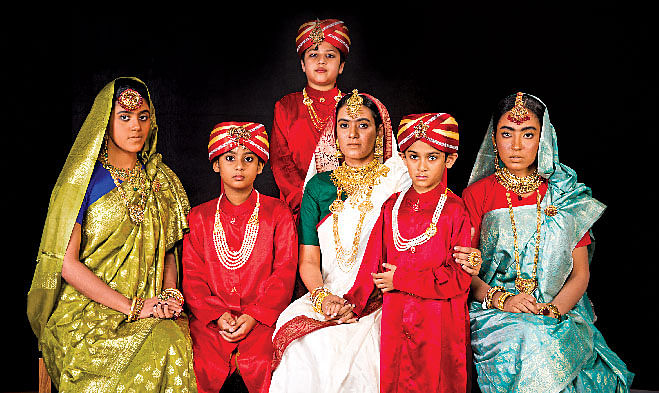HAL KHATA

They say mankind is the slave of time. Time, too, is the slave of man. Time is an unfathomable and mysterious concept. We do know -- based on rationality -- that it moves forward. But we've taken the liberty to break it down into days and nights, to imprison it into the mechanics of a clock, and to structure it with a calendar.
And based on culture and needs, there are different calendars, and thus various organisations of time. The Bengali calendar was promoted by Mughal Emperor Akbar -- consistent with the harvest cycle to ease tax payment.
This organisation of time is followed till this date by a vast number of businesses all over Bengal. And every new year -- Pohela Boishakh that is -- businesses open their new ledger book, the new hal khata.
Often red in colour, it's a simple ledger book. But at the beginning of a new year, it signifies much more: the marking of a new beginning and the hopes and uncertainties that come along with it. And more importantly, the hal khata represents our tradition, with the festivities and rituals surrounding it.
Jewellery shops are a good example. They make elaborate preparations to welcome the New Year, to open their new ledger book. Shops are meticulously cleaned and decorated with flowers. An abundant amount of sweets are purchased for guests. Gifts are wrapped. Invitation cards are printed and sent out. Important customers receive phone invitations.
Nusrat Khusbo, a housewife living in Gulshan, always visits two jewellery shops in her area. “Since I'm their regular customer, I always get invited for Pohela Boishakh, and I make it a point to visit them. The shops will pamper their customers with gifts such as mugs and jewellery boxes and with food, which include a wide range of sweets, phuchka, luchi and other things. Many shops also produce new designs for the occasion,” she said.
Tanti Bazaar, one of the oldest localities in Dhaka, houses numerous small jewellery shops on the sides of its narrow alleys. Many of these shops are old, with business being handed down from one generation to the next.
In the span of several generations, things have not changed much. “The opening of hal khata is an important day for us,” opined Shankar Ghosh, who runs a shop in Tanti Bazaar. “The ledger book is commenced through worship.”
The timing of the inauguration of ledger book varies from year to year. “Based on calculations, it is decided exactly which period is the most auspicious and suitable. And we strictly adhere to that schedule,” Ghosh informed.
Shankar flips open the bulky red book. The first page does not contain any numbers; no expenditures or revenues noted. Instead, in the middle of the page, were a few written lines each comprising of the name of a god or goddess or saint -- Shree Shree Ganesha namo...Shree Shree Durgamata namo...Shree Shree Maa Lokki namo...
Often, the page contains an imprint of a coin, done on vermillion or other symbolic materials.
'Puja' is held at many shops. In Tanti Bazaar, the whole thing happens on a larger dimension. The worship of Lord Ganesha is held centrally on the street, where a large, decorative stage is built. Amidst huge crowds and a large number of devotees, the entire Tanti Bazaar rises up to festivity, glory and worship.
The tradition of hal khata is of course not the monopoly of any one religion. Shibly Sayed is a Muslim jeweller in Tanti Bazaar. The opening of hal khata is as important to his shop as it is to his compatriots. “After much cleaning and decorating that goes beforehand, we hold a 'milad' to start off the New Year, and the ledger book itself,” he informed.
And, the tradition of hal khata is not the monopoly of jewellery shops -- or that of retailers at large. The importance of hal khata runs across various types of businesses.
After all, if you are managing a business, you need to keep accounts. Ledger book is an inevitable tool. And whenever you are keeping accounts, there needs to be a financial period for practical reasons.
Now, the time period you choose to a certain extent reflects your heritage, your values and your tradition, and your mode of doing business. Would you follow the Gregorian/Western calendar? Would you stick to our government's July-to-June fiscal calendar?
Again, it's your perception of time, based on your beliefs and needs. There is even a discrepancy about how people define the Bengali calendar. Many people celebrate Pohela Boishakh on 15 April instead of 14 April.
“Although the government recognises Pohela Boishakh on 14 April, a lot of us celebrate it the next day according to our tradition,” says a trader in Tanti Bazaar. “Thus, we open hal khata and conduct all the rituals and festivities a day later.”
Time is an obscure reality; we just try to give it a shape according to our best understanding.
The notion of hal khata has survived the test of time; this tradition has been going on for ages. Besides upholding your heritage, the hal khata tradition has survived because, well, it works; it has many practical benefits.
It is a day you aim to clear debts, and it is a time to establish a stronger relationship with your customers and other stakeholders -- a symbolic day with very sensible accounting and marketing functions.
What does the future hold? Will we see the 'digital hal khata' one day? Well, a hal khata is essentially a spreadsheet after all. With affinity towards technology increasing every day and across the spectrum of generations, will the traditional hal khata disappear one day?
It already has, for many companies -- from the perspective that instead of keeping records in a book, they now use a digital spreadsheet. But what about the small, traditional shops where hal khata, in its original form, conveys a lot of meaning?
Probably this change won't occur -- at least not any time soon. And even if it does, the rituals and celebrations surrounding hal khata need not change.
But then again, it is only time that can tell how dearly the hal khata culture will be embraced in the future.
So far, it stands strong, with a lot of glory. Hal khata, which is such a time-bound thing -- with a rather mundane function -- has somehow managed to become timeless.
Model: Holy, Muna, Rifat, Ahbab, Nahal, Sreya
Sari: Manick Banarashi
Jewellery: Khubsoorat
Kids attire and blouse: Chondon
Make-up: Farzana Shakil

 For all latest news, follow The Daily Star's Google News channel.
For all latest news, follow The Daily Star's Google News channel. 



Comments